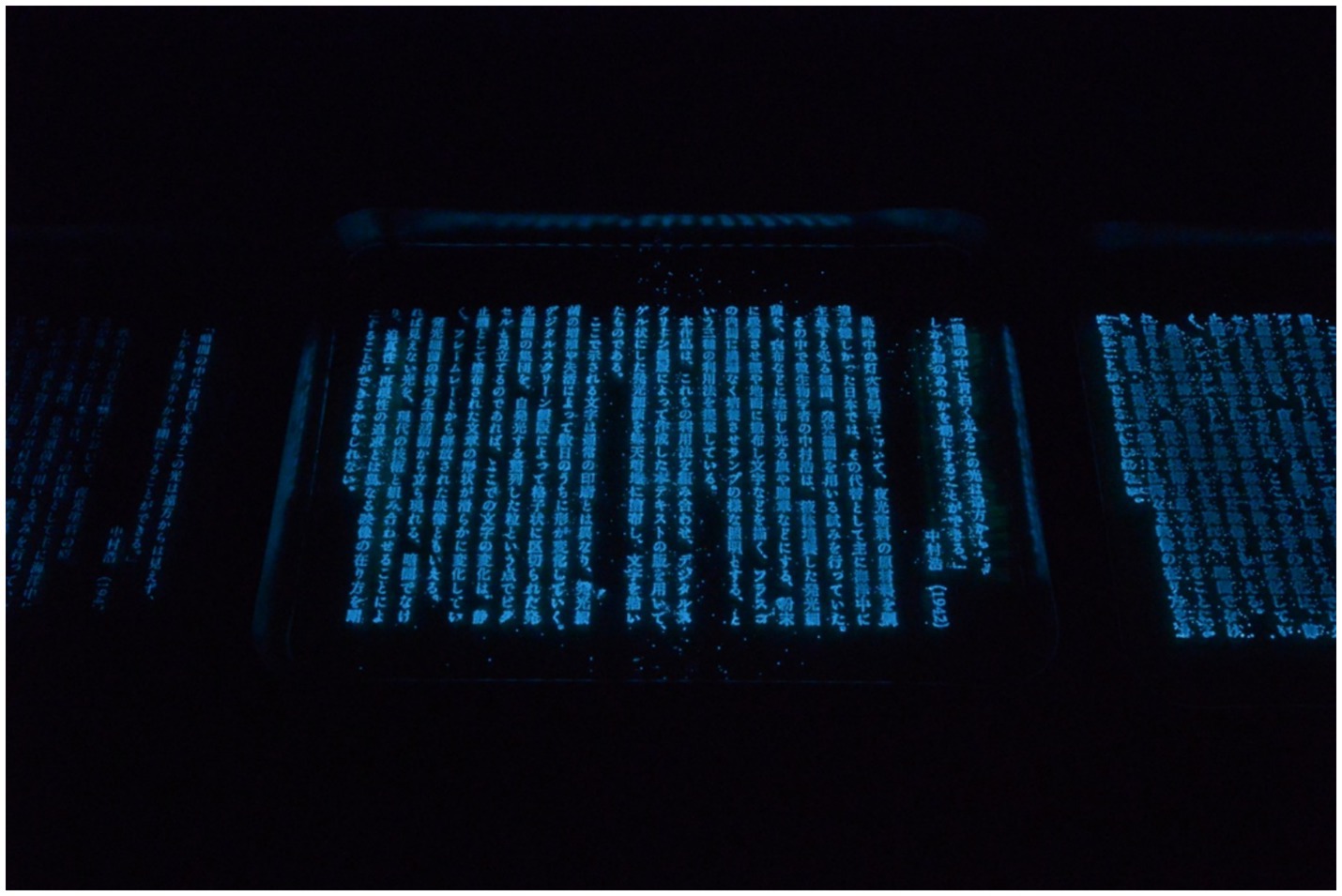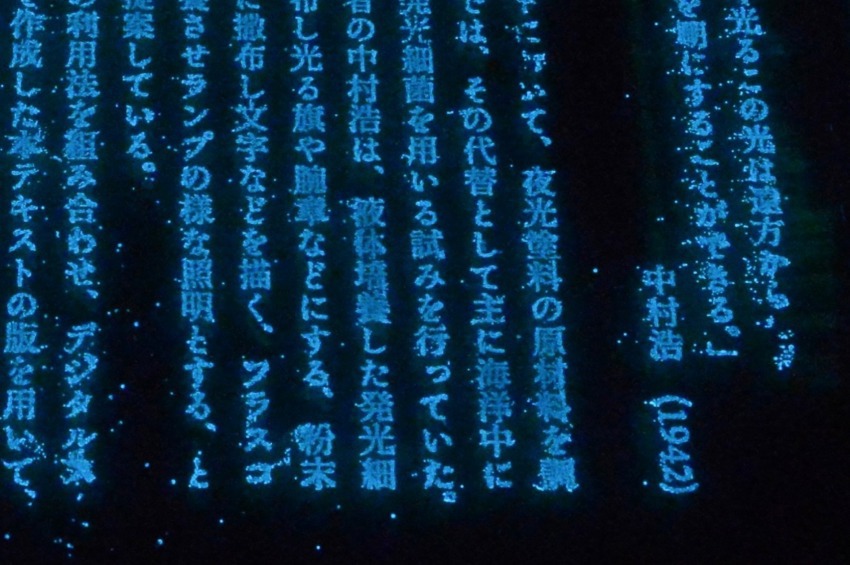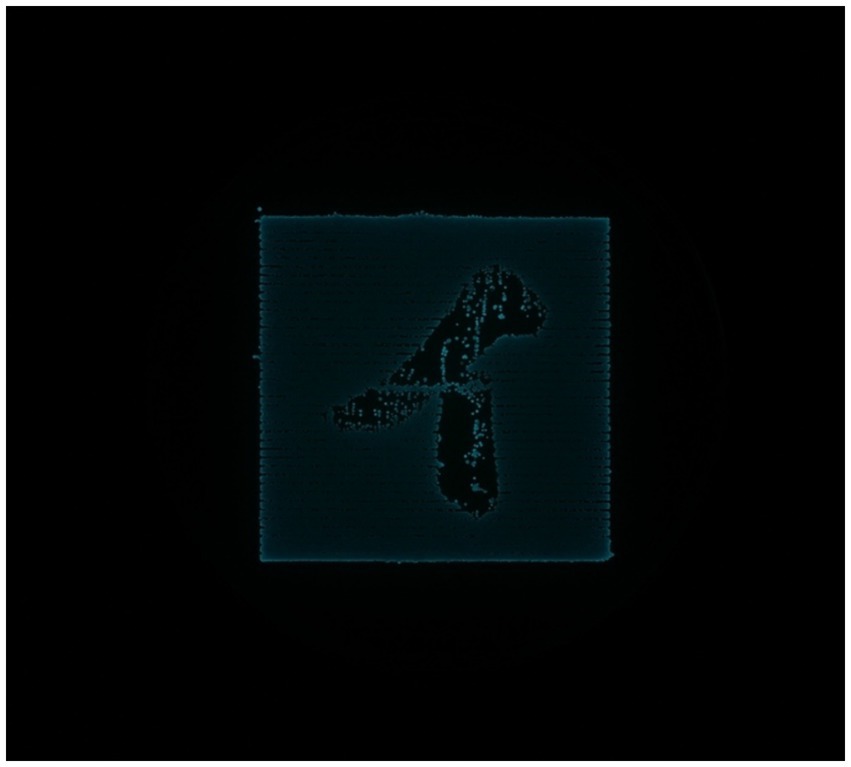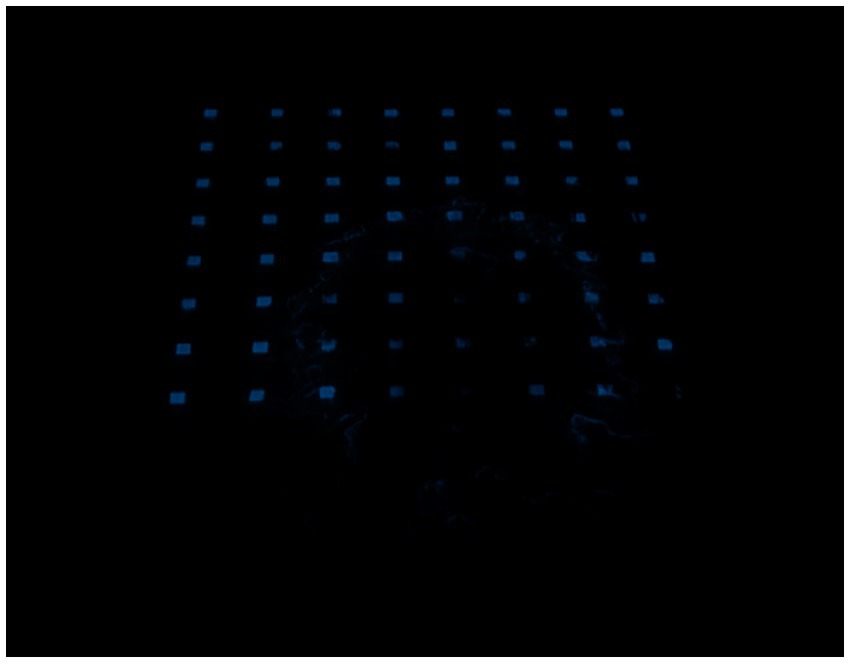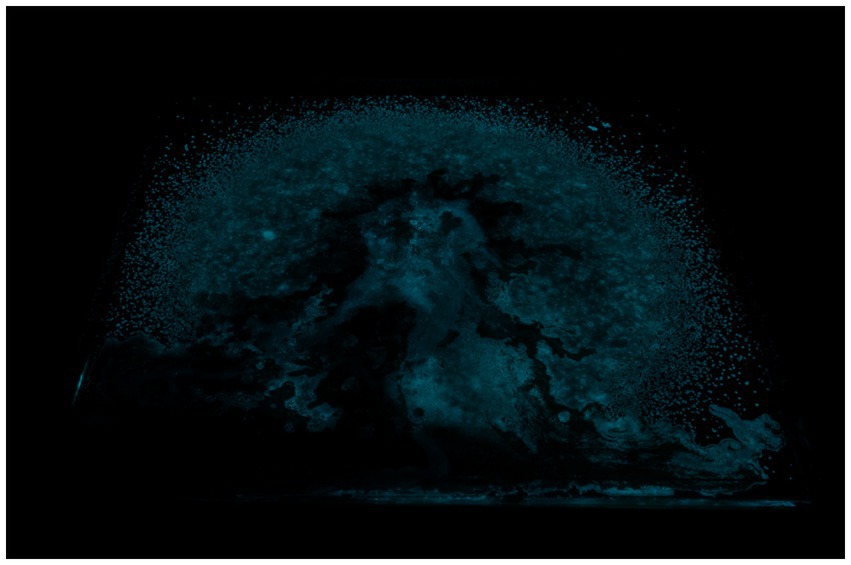- 1Graduate School of Design, Kyushu University, Fukuoka, Japan
- 2Faculty of Design, Kyushu University, Fukuoka, Japan
In the current media environment, John Durham Peters emphasizes the importance of non-verbal communication and notes that underpinned by digital technology, “media” is returning to its original meaning as the milieu that surrounds living beings. To concretize and critically discuss this idea, this paper examines the artworks created by the authors, which incorporate microorganisms into digital technology. These works applied luminous bacteria as ink to digitally screen print text and images. The first work, A Medium for Images or Luminous Bacteria (2022), prints Japanese text with luminous bacteria ink. The second work, ‘イ(I)’ (1926) by BioLuminescent Bacteria (2024), recreates the first image in the history of Japanese television, ‘イ(I)’, with luminous bacteria. This paper compares and analyzes these practices in light of classical media theory, including the work of William Ivins Jr. and Marshall McLuhan. The paper introduces another work, Grow.|Glow. (2023), to further expand the discussion to contemporary digital media. Finally, drawing on the recent arguments of Anna Tsing and Antonio Damasio, we elucidate the critical implications that the works of luminous bacteria bring to the current media environment.
1 Introduction
In his book, The Marvelous Clouds (2015), media scholar John Durham Peters estimates the current media environment as follows: whereas traditional media understanding has developed based on one-to-one or one-to-many communication models, with the advancement of digital technology including the internet, the 21st-century media environment has become an encompassing network surrounding us. In this sense, “media” reverts to its original meaning as the milieu surrounding living organisms. From this perspective, he examines the communication of non-human animals, such as dolphins and whales, which use ultrasound, ultimately arguing the importance of non-verbal communication.
“Currently nonverbal signifies the remainder that is left when you take away language from human communication, but it ignores the meaningfulness found in nonhuman nature. How odd to describe that part of communication that most ties us to nature as lacking! (p.380).”
Acknowledging the current situation where digital technology has become our surrounding milieu, it becomes increasingly important to focus on the nonverbal communication that is often overlooked due to the efficiency of these technologies that is particularly the case when considering communication with non-humans. In effect, Peters draws attention to the fact that “our bodies are embedded in climate history, fire regimes, the spin of the earth, north and south, and relations with plants, artifacts, and organisms of all kinds, especially each other” (p.380).
These ideas are intriguing as they open up the concept of communication, traditionally understood exclusively from a human perspective, to the relation with non-human realm. However, the last point, quoted from the concluding part of work of Peters (2015), sets the agencies of non-verbal communication so broadly, ranging from artifacts to other organisms, that it becomes difficult to pursue a specific discussion.
This paper aims to concretize and extend these ideas critically by examining our works that integrate a form of nonhuman life, bioluminescent bacteria, with screen printing realized by a recent digital technology. By comparing and analyzing the significance of non-verbal communication in these works against classical discourses in media studies, the paper seeks to reconsider these ideas. To this end, the following section will present the techniques common in the works A Medium for Images or Luminous Bacteria (2022) and ‘イ(I)’ (1926) by BioLuminescent Bacteria (2024) (Figures 1, 2), comparing them with the arguments on print technology and television by scholars such as William Ivins Jr. and Marshall McLuhan. Finally, by examining another work, Grow.|Glow. (2023) with reference to the arguments of Anna Ting and Antonio Damasio, the paper will consider the (im)possibility of non-verbal communication with nonhumans and elucidate the critical significance of these findings for the current media environment.
2 Materials and methods
2.1 Bioluminescent bacterial ink
The works created by the authors all employ a unique print media that is made possible by culturing luminous bacteria and converting them into ink. The printing technique involves a culturing medium of the agar as the support, and digital screen printing, a form of computer-mediated reproduction technology. This method, a type of screen printing, uses a mesh stencil with cut-out text or shapes to apply ink, and today, computer-controlled printing based on binary images is possible.
However, unlike conventional ink, the bioluminescent bacterial ink remains alive on the agar medium, necessitating a constant supply or care of nutrients from the medium. Additionally, the figures created by the bacterial colonies in a mosaic pattern continue to change unpredictably after printing. Due to the faint light emitted by these bacteria, which inhabit ordinary marine environments, a completely dark room is required for exhibition, where viewers must wait for several minutes before they can see the work with the naked eye. Furthermore, these bacteria do not emit light as single organisms. This is because the emission of light is controlled by the detection of population density by the bacteria as a group. This is called Quorum Sensing and is realized by individual bacteria sending and receiving autoinducers to and from each other (Miller and Bassler, 2001). By this system, blue-green luminescence is initiated only when the bacterium is multiplied at a constant density. This suggests the presence of chemical-based communication among individual bacterial cells.
In addition, this phenomenon is not exclusive to luminous bacteria because some species are known to have symbiotic relationships with other marine organisms, such as squid and anglerfish, for the ecological interdependence (McFall-Ngai, 2014). These host organisms have specialized organs that provide nutrients to the luminous bacteria. In return, as the bacteria proliferate within these organs, they serve as light-emitting organs for the hosts, aiding in predation and mating. Despite the confirmation of such symbiotic relationships, the purpose behind the luminescence of the bacteria themselves remains unknown.
The authors cultured luminous bacteria in a liquid medium and absorbed them into gelatin to create ink. Specifically, the luminous bacteria were cultured for 24 h in Marine Broth 2216, a liquid medium designed for marine organisms, and then absorbed into 5% gelatin. When thickening agents like xanthan gum were used to create a paste, the luminous bacteria died. Therefore, the authors referred to previous examples of luminous bacteria in Japan and succeeded in creating bacterial ink using gelatin.
2.2 Digital screen printing
With regard to the silk screen printing used with this ink, this technique involves passing ink through a screen stencil to print images onto a substrate. Typically, the screen is a mesh fabric stencil coated with a UV-sensitive emulsion. The areas where ink is to pass through are blocked with a negative image during exposure. This allows for gradient representation through halftone and the resolution is determined by the number of mesh threads per inch. Historically, screen stencil printing has been used in various cultures for centuries, but an original technique of silk screen printing as mentioned above emerged almost simultaneously in the United States and Europe from the late 19th to the early 20th century (Lengwiler, 2013). Today, digital control allows screen stencils to be created by burning holes into the screen using heat, enabling its production directly from digital images without manual intervention.
Using this digital silk screen printing method, the authors created works by printing luminous bacteria onto agar media. The agar substrate was made by solidifying the same medium used for ink creation with 1.5% agar. Image data were created using Adobe Illustrator, and the screens were made using a Mi Screen A4 screen maker and 120 mesh screens. After tightly affixing the screens to the agar substrate, luminous bacteria were applied, and the screens were immediately removed, allowing for the printing of our original ink. In other words, these works can be realized as living prints created with nonhuman agencies.
The bioluminescent ink reaches its peak luminescence approximately 24 h after printing, necessitating careful timing in preparation relative to the exhibition’s opening. Due to the faintness of the emitted light, a completely dark room is essential for the human audience to perceive it. This condition requires darkrooms for preparation and exhibition, such as the room for photo development, where the author and audience are completely blocked off from external light and concentrate on viewing the self-illuminating work. The works in a dark room for several days, and viewers must allow their eyes to adjust to the darkness for a few minutes after entering the space to perceive the images. Only after undergoing this process can the work be properly viewed, however, the initial figures of living prints transform gradually for the period of exhibition so that viewers can never see the identical image.
2.3 Discourses
In considering works that utilize such materials, we would like to confirm and review classical discourses related to visual communication at first because our works are based on traditional communication methods such as printing (on paper) and television, as detailed later. Here, we will examine the arguments of two scholars, William Ivins Jr. and Marshall McLuhan, who have analyzed these media, respectively, more than half century ago.
First, in his 1953 seminal work, William Ivins Jr. defined visual language as exactly repeatable pictorial statements, and explored how this concept has evolved primarily since the Renaissance (Ivins, 1953).
“The printing of pictures, however, unlike the printing of words from movable types, brought a completely new thing into existence it made possible for the first time pictorial statements of a kind that could be exactly repeated, during the effective life of the printing surface. This exact repetition of pictorial statements has had incalculable effects upon knowledge and thought, upon science and technology, of every kind. It is hardly too much to say that since the invention of writing there has been no more important invention than that of the exactly repeatable pictorial statement” (pp. 2–3).
Ivins Jr. positioned “the exact reproduction of pictorial statements” as a historical invention, comparable to the invention of the letterpress, emphasizing its significant role in the development of modern science including engineering, archaeology, and ethnology (Ivins, 1953, pp. 2–3). From his perspective on the history of visual communication, the precise replication of images is fundamentally different from the printed text, which still has the auditory nature involving “the necessary arrangement of word symbols in a time order.” Because through the introduction of printed images, even perceived through the visual sense, “we see a picture first as a whole, and only after having seen it as a whole do we analyze it into its component parts. We can begin this analysis at any place in the picture and proceed in any direction, and the final result is the same in every case” (p. 75).
In other words, while textual media and their associated descriptions and interpretations follow a linear order, visual communication through images leads to disrupting this traditional linearity. Certainly, up until the 18th century following the invention of prints enabling the reproduction of images, interventions by draftsmen and engravers inevitably distorted the original drawings, necessitating specific pictorial techniques during plate production. Therefore, Ivins Jr. highlighted the revolutionary impact of the halftone technique, which emerged in the 19th century and enabled mass printing of photographs, emphasizing it as follows:
“In the improved half-tone process, there was no preliminary syntactical analysis of the thing seen into lines and dots, and the ruled lines and dots of the process had fallen below the threshold of normal vision…At last men had discovered a way to make visual reports in printer’s ink without syntax, and without the distorting analyses of form that syntax necessitated” (p. 128).
Viewed in this context, the transition from the dominantly linear nature of written language to visual communication via “exactly repeatable pictorial statements” could be seen as completed through the halftone technique and, consequently, the “cross-line screen.” In contrast to the mass production of colored playing cards using stencils in medieval Europe, several technologies for stencils with parts connected by strings emerged from the end of the 19th century in America and Europe, as we mentioned above; from the patent obtained by Benjamin Walker in 1884 in the U.S. for attaching stencils to wire mesh, to the one of Jehan Raymond in France and England at 1906 and Samuel Simon in England at 1907 using silk gauze in stencils.
The simultaneous emergence of the technology for silk screen printing might be described as completing a historical transition from textual to visual communication. In any case, such technical frameworks have certainly integrated with digital technologies up to the present. In short, the lineage of visual communication emphasized by Ivins Jr., which replaced grid-like materials with lace, metal, and ultimately pixels, has been passed down to current communication tools dominated by computation and pixel-based digital displays.
Ivins’ exploration of visual communication history may be perceived as somewhat biased because it centered around the reproduction of artworks. It was Marshall McLuhan who engaged in a broader cultural discourse on communication succeeding the former’s arguments, but not limited to artistic ones. His 1964 groundbreaking work, Understanding Media, traces the historical evolution of media technologies and is famously known for its thesis that “the medium is the message,” focusing more on the psychological and social effects of media formats rather than their content (McLuhan, 1964).
For example, using the analogy of electric light, he explained:
“The electric light escapes attention as a communication medium just because it has no ‘content’. And this makes it an invaluable instance of how people fail to study media at all. For it is not till the electric light is used to spell out some brand name that it is noticed as a medium. […] For electric light and power are separate from their uses, yet they eliminate time and space factors in human association exactly as do radio, telegraph, telephone, and TV, creating involvement in depth” (p. 9).
The characteristics of light discussed here will also influence our artworks. Before delving into that, it is essential to confirm McLuhan’s distinctions between different levels of involvement or participation across various media, expressed through the famous terms “hot media” and “cool media.” While hot media refers to high-definition media such as printed words or photographs, which are characterized by low viewer participation, cool media refers to relatively low-definition media where sensory or physical participation and involvement from the viewer are required. Among these, television is a low-definition image with scanning lines, compared to high-definition traditional visual media such as photography and cinema. In other words, it has become a privileged object of “cool media,” due to its use of a “mosaic form” which was believed to enhance viewer participation compared to traditional visual media.
“TV is, above all, an extension of the sense of touch, which involves maximal interplay of all the senses. […]Phonetic writing, alone, has the power of separating and fragmenting the senses and of sloughing off the semantic complexities. The TV image reverses this literate process of analytic fragmentation of sensory life (p.333).”
McLuhan, who posited that media technologies themselves determine the content of communication, viewed television as a technology enhancing tactile sensitivity, in other words, inducing sensory effects vastly different from visual extensions like photographs and text. Television, classified as a “cool” medium, was explained as an extension of tactility because it mobilized viewers’ bodies and senses, while simultaneously integrating the sensory fragmentation and disintegration historically caused by traditional textual media. Thus, McLuhan’s perspective, although slightly divergent in focus, shares commonalities with Ivins’ discussion of reexamining the forms of media communication from the historical perspective of techno-civilization.
When juxtaposed with these classic theories of communication and media, how can we interpret our own works? Although the classic arguments by these two media theorists offer a stimulating perspective even today, it is also true that they retain a partially anthropocentric viewpoint. Whether drawing inspiration from their debates around print technology or television media, then, what kind of effects might arise when non-human agencies such as luminous bacteria are introduced into a human-centered communication system, which were absent in their discussions? In the following sections, we aim to investigate these effects based on the individual specificities of our artworks.
3 Results
3.1 A Medium for Images or Luminous Bacteria (2022)
Actually, the creation of images through luminous bacteria is not our novel endeavor. A pioneering example dates back to World War II in Japan, where the potential use of luminous bacteria was explored (Harvey, 1952). Among the Japanese microbiologists, Hiroshi Nakamura investigated the use of these bacteria as a low-intensity lighting solution during nocturnal air raids, addressing the scarcity of domestically produced luminous paint due to material shortages. Because these bacteria were easily harvested from the nearby Pacific Ocean (Nakamura, 1942), he proposed creating emergency signs by applying them like ink or adhering them to powder to draw letters and symbols (Nakamura, 1940).
While the details of this historical background are discussed in a separate article (Saeki et al., in print), A Medium for Images or Luminous Bacteria critically reinterprets this wartime history by repurposing the bacteria as a medium for print. In fact, the Japanese text (re)printed in this artwork are cited form Nakamura’s original research explaining the conception of this work with bioluminescent bacterial ink (Figure 3). The following is an excerpt from the introduction of the work.
“The blue-white glow in the dimness is unseen from afar, yet it can unveil the whereabouts of objects” (Nakamura, 1942 trans by authors).
Thus, while Nakamura advocated for the utility of luminous bacteria, the shapes of the letters in this work are physically disrupted as the bacteria proliferate. In practice, the piece employs a method where one print is produced each day using the same screen, exhibited over 5 days. As a result, each print varies significantly, not only due to changes occurring every 24 h but also because of the correlation between individual differences of bacteria and external factors such as humidity and temperature.
Viewers must allow their eyes to adjust to the darkness before they can perceive the work, thus reading and learning about the wartime use of luminous bacteria only after spending a certain amount of time. Concurrently, the piece transforms the letters and figures constantly but imperceptibly: as the bacteria grow, the fixed typography and layout established by digital silk-screen printing gradually deteriorate. In this way, the work transitions from concrete text to abstract imagery through the growth of luminous bacteria. This transformation embodies the shift from a wartime application to an artistic one that illustrates a process where anthropocentric attempts to utilize biological organisms during wartime are deconstructed by the very microorganisms themselves.
3.2 ‘イ(I)’ (1926) by BioLuminescent Bacteria (2024)
The work ‘イ(I)’ (1926) by BioLuminescent Bacteria connects the spontaneous luminescence of living print with the history of CRT (cathode-ray tube) technology developed for the television (Figure 4). Initially not necessarily conceived as a one-to-many communication technology, television was formed in the first half of the 20th century through intense development competition from the United States to Europe and Japan (Abramson, 1987). Kenjiro Takayanagi is one of the Japanese pioneers who enabled the transmission and reception of television images using a cathode ray tube (Suematsu, 2006). Takayanagi believed that mechanical receivers could not display high-definition images, so in 1926, he combined a Nipkow disk in the transmitter and a CRT display in the receiver to successfully transmit and receive images. At this time, the katakana character ‘イ,’ was chosen as the image to transmit, which is equivalent to the letter ‘A’ in the modern Japanese syllabary order (iroha order) commonly used at the time. Takayanagi allegedly transmitted and received the character ‘イ’ written with a brush and ink on mica using 40 scanning lines (Miura, 2006). In the 1920s, research using cathode ray tubes was also being conducted by Westinghouse’s Zworykin and Philo Farnsworth in San Francisco, who attempted to apply them to imaging devices. However, only Frank Gray at Bell Telephone Laboratories and Takayanagi were researching their use in receivers.
In our artwork recreating this symbolic image with luminous bacteria. The ‘イ’ gradually appears, composed of 40 scanning lines as the bacteria proliferate. Over time, the character is distorted by the bacteria’s life activities, eventually connecting the scanning lines and transforming from a mosaic form into a continuous large surface. This change progresses mainly due to the influence of external environmental factors as well as the previously discussed work. For the viewers a process known as dark adaptation (Kalloniatis and Luu, 2005). Dark adaptation involves the switching of photoreceptor cells on the retina, which not only enhances brightness perception but also alters color perception. Because the degree of dark adaptation varies among individuals, each viewer perceives differently the colors of ‘イ’ composed by the bacteria, despite having the common feature with cathode-ray tubes that they emit light themselves.
3.3 Revisiting the classical media theory through the nonhuman
Given this specificity of our work as such, we would like to confirm again the discussion of Ivins Jr. which regarded the pictorial replication as an extraordinary step “[i]n the whole history of human communication.” It is because this technology that did not necessarily require the human intervention of a draughtsman and engraver and “[m]an had at last achieved a way of making visual reports that had no interfering symbolic linear syntax of their own” (pp. 176–177) of the traditional textual information. While the automation of such operations might seem unremarkable from today’s perspective, it is undeniable that this process has undergone further refinement, especially with the advent of computers after the publication of Ivins Jr.’s work, leading to advancements from contemporary text editing software to AI-driven automatic generation (Manovich, 2010).
In contrast to the technological advancements, A Medium for Images or Luminous Bacteria adopts the simple and mechanical aspects of printing technology akin to halftone in the form of a “digital screen.” Simultaneously, it incorporates the nonhuman agency of luminescent microorganisms, allowing viewers to experience the disruption of the printed output. As the luminous bacteria activate and eventually perish, the printed text loses its legibility, and the human communicative tool of linguistic information becomes dysfunctional along with the enabling digital technology. Our work (re)introduces an agency different from both humans and machines into the process that operates “below the threshold of normal human vision,” to paraphrase Ivins Jr.’s words, which halftone originally had achieved.
Consequently, the process of disassembling written language in this work can be viewed as an attempt to reorient historically text information predominantly optimized for human communication through a form of non-human communication from a historical and critical perspective. Furthermore, the decomposition of the content drawn from wartime text and contexts makes it possible to reflect the purpose of military technology, an excessive manifestation of human technological advancements, with the aid of non-human agency. In this sense, the work can be situated as a critical endeavor aimed at challenging anthropocentric views of technology.
Similarly, let us proceed to examine another work in light of McLuhan’s theories on television. In addition to his anthropocentric perspective on media and body, McLuhan’s assertion that the low resolution of the television, which was rapidly proliferating during his lifetime, leads to prompts the “complex sensory involvement” among its viewers might seem incongruent with the current media environment, where LCD/LED monitors are ubiquitous in competing to achieve extremely high resolution and control below the threshold of human vision (ex. Retina Display). Nonetheless, much like his prophetic concept of the “global village,” so-called attention economy, which prioritizes captivating human senses through countless network-connected monitor displays, could be considered to enhance “complex sensory involvement” actually even more than television once did.
‘イ’ (1926) by BioLuminescent Bacteria was conceived as a critical response to this contemporary media environment. Takayanagi’s choice of the character ‘イ,’ the first character in the traditional Japanese Iroha order, likely stemmed from an ambition, whether conscious or unconscious, to position himself at the forefront of the burgeoning global competition in media technology development. Moreover, in line with McLuhan’s theories, Takayanagi’s endeavor can be seen as an attempt to overlay the hot medium of print extending the sense of sight through phonetic characters onto the cool medium of television, which significantly alters sensory modes. In contrast, ‘イ’ (1926) by BioLuminescent Bacteria reassembles the symbolic character image with luminous bacteria, which self-illuminate similarly to a television CRT. As these microorganisms gradually deconstruct the character-image, the piece not only introduces non-human agency into the media history transition from print to television, but also invokes the ongoing interplay between technological advancement and biological processes.
Furthermore, it should be noted again that the bioluminescent patterns appear in different colors depending on each viewer’s level of dark adaptation. This feature embodies the human sensory response to low-resolution images described by McLuhan as “tactile extension.” Audiences are prompted to mobilize sensory participation and involvement beyond vision as they attempt to discern faintly emerging images amidst the visual deprivation of darkness. However, recalling critiques of McLuhan’s media theory as sometimes leaning towards technological determinism, in this case, such effects derive not from the technical characteristics of CRT but rather from the properties of nonhuman microorganisms that glow only when gathered in darkness. As a result, while starting from the same ‘イ’ as a reference point, these features can be understood as highlighting a critical and alternative lineage to the current media environment, which subjects our attention towards singular content of information through television media, computers, and the internet.
4 Discussion
4.1 Grow.|Glow. (2023)
The discussions by Ivins and McLuhan examined the changes media technologies bring about on a perceptual level, preceding meaning or message, from a historical perspective of civilization. Drawing inspiration from these discussions while incorporating the agency of microorganisms, how can be explained our works’ critical significance not only in relation to traditional media such as print and television but also in the context of contemporary digital technology? To further explore this point, we would like to introduce one final piece (Figure 5).
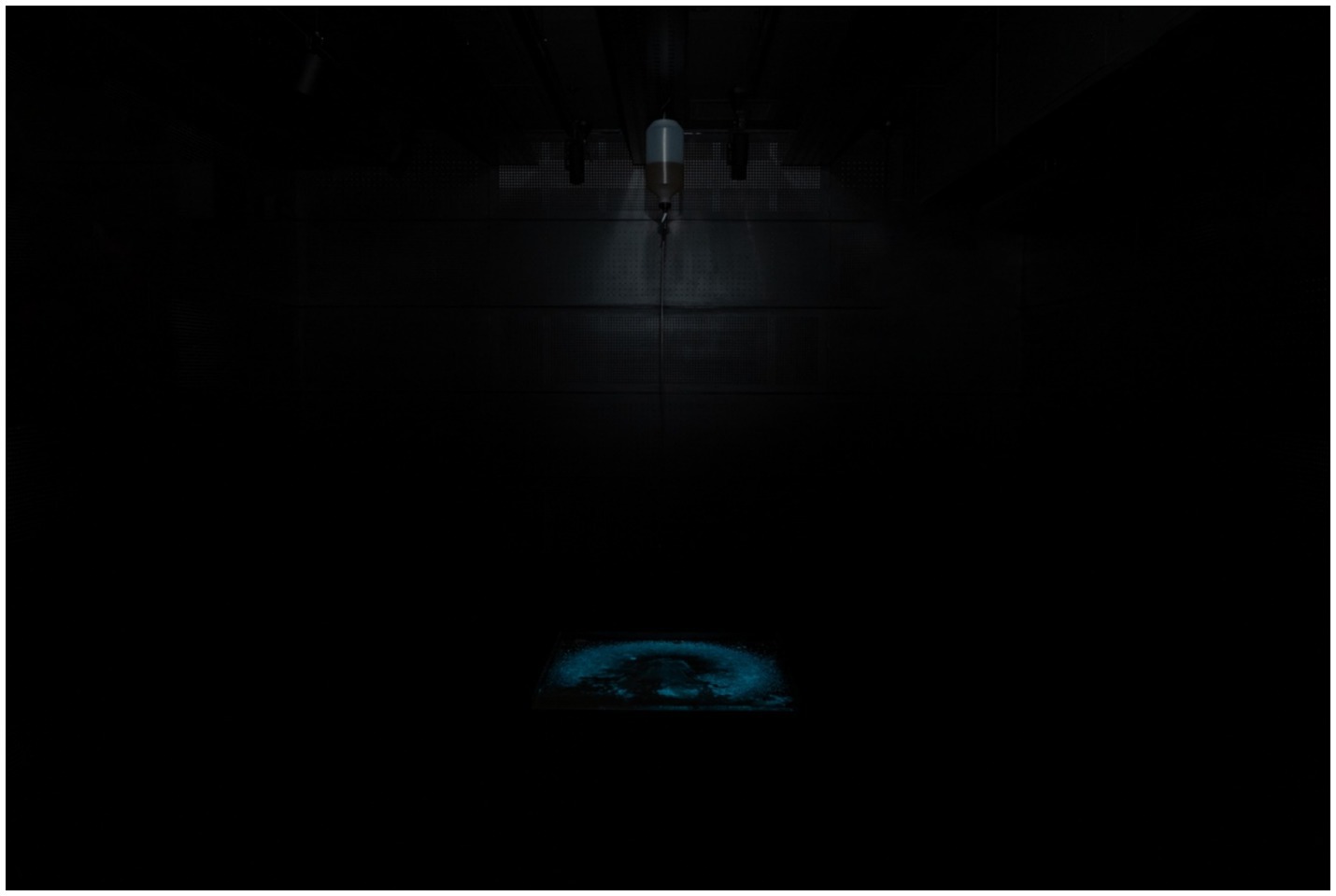
Figure 5. Grow.|Glow. (2023): overall, 1 m square medium set up horizontally, with culture medium supplied from the ceiling.
Grow.|Glow. (2023) is an artwork that overlays luminous bacteria on the grid structures similar to circuits and pixel images, which are fundamental to contemporary digital technology (Figure 6). A large medium, 1-m2, is laid flat in a darkroom, initially printed with luminous bacteria in a grid pattern. From above, a device similar to an intravenous drip system continuously supplies culture medium throughout a 1-week exhibition. Where the grid patterns of luminous bacteria are shaped and highlighted, as nourished by the culture medium, they grow and spread unexpectedly, then eventually transform into abstract patterns. In fact, the printed grid begins to expand into circular shapes as the culture medium spreads by the second day and, the original grid structure is entirely collapsed into a large continuous surface by the third day. Thereafter, the luminous bacteria extend beyond the boundaries of the initial patterns, proliferating into the surrounding area. Concurrently, countless glowing particles emerge sporadically and subsequently, and the grid occasionally happen to reappear with unpredictable transformations (Figures 7, 8).
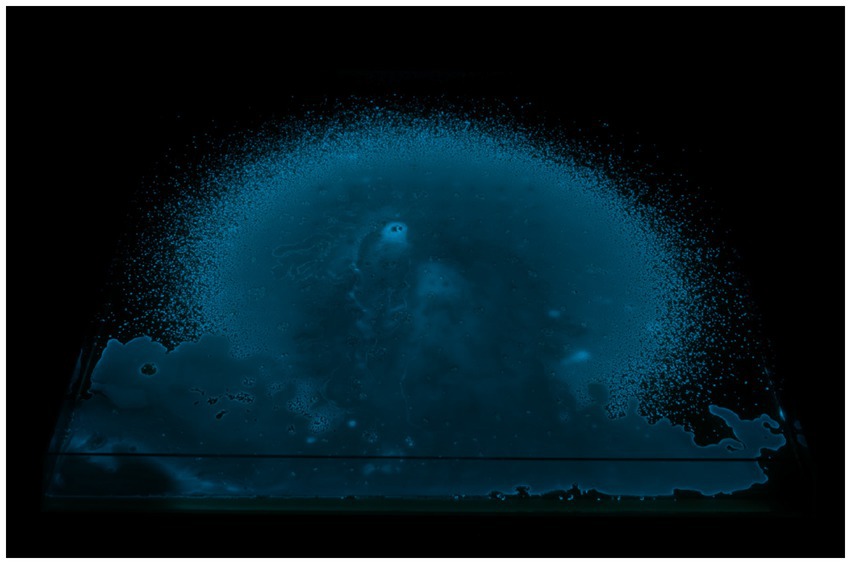
Figure 7. The third day: transforming into a large continuous circle shape and after-the-fact emergence of glowing particles.
These phenomena suggest that the luminous bacteria induced changes of their medium through their proliferation. The proliferation of bacteria and the decrease of ingredients cause an imbalance in their population within the medium, and that led to a decrease in the pH making it no longer a viable environment for survival. This environmental change prompted the bacteria to proliferate toward the outer regions where nutrients were still available, resulting in the observation of glowing along the periphery and in scattered locations. However simultaneously, due to the continuous supply of culture medium from above, the medium conditions eventually can be considered to revert to a more favorable state, allowing the surviving bacteria in the central region to resume growth, causing the grid pattern to reappear.
Thus, the emerging images bring about not only long-term changes of shapes over several days but also minute variations of perceptual experience for audiences situated in the dark environment. In the case of Grow.|Glow., viewers sit in chairs installed for observation and, over several minutes to hours, gradually adjust to the darkness to stare at the artwork. During this time, frequent reports noted a faint wriggle and vibrate of bluish-white light within the viewers’ field of vision. While the exact cause remains uncertain, it is unlikely that individual movements of each organism were perceptible, given the size of the luminous bacteria. Instead, this phenomenon is thought to be rooted in the physiological characteristics of human vision. In the darkness, viewers are unable to perceive peripheral visual information, thus they cannot correct saccade movements of their eye in response to luminous bacterial images covering a specific field of view. Consequently, viewers perceive a subtle trembling of their eyeballs in the image they are observing.
4.2 Revisiting the digital media environment through the nonhuman
Such features suggest a tendency completely opposite to modern visual media, which strive to stabilize content by excessively enhancing brightness and resolution. It also evokes John Durham Peters’ observation, as quoted at the beginning, which argues the significance of reconsidering nonverbal communication in environments that encompass not only humans but also non-human organisms. However, while he carefully avoids detailed references within that context, it is a fact that interpreting animal behaviors, including dolphins or whales, as communication models often unavoidably falls into the form of anthropomorphism. On the contrary, it is hard to imagine anthropomorphism on luminous bacteria featured in our work, nor does this work attempt to consider the behaviors of micro-organisms as a metaphor for human beings. A vastly different scale of agency from humans suggests a sensory function that illuminates media as an environment and foregrounds nonverbal communication through the bodily and perceptual levels.
Of course, it is also true that current digital technologies are transforming media into environments rather than specific devices, such as the Internet, GPS, sensing technologies, and others. Even when focusing on imaging technologies, for instance, projection mapping creates expansive spectacles surrounding numerous audiences by adapting images onto arbitrary large surfaces like buildings. Furthermore, XR technologies merge real and virtual spaces, attempting to extend immediately individuals’ visual fields through displays. While these technologies indeed illustrate how digital technology can transform the surrounding environment into media, they achieve this by overlaying a grid structure optimized for digital control onto physical space. Thus, no matter how much the real world is augmented, digital images fundamentally cannot escape the pixel grid structure.
Anthropologist Anna Tsing critically examines these tendencies of technology and points to behind it the relentless drive toward expansion as a characteristic of capitalism (Tsing, 2012):
“The digital image is made bigger or smaller by resizing the pixels. Of course, pixels must therefore remain uniform, separate, and autonomous; they cannot bleed into each other or transform each other. Artists complain about pixelation, which fragments our vision of the world. Most of us do not care. But what made this technology so easy to imagine, I would argue, is the pixelated quality of the expansion-oriented world, which is something we ought to care about.”
Here, scalability embodied by pixels refers to the ability to change the scale of an image without altering its content. However, as a consequence, enabling the enlargement of an image necessitates reducing it to uniform and homogeneous units (pixels), which risks expelling the diversity that each image or object inherently possesses. Tsing thus points out that these distinctive features of pixels underscore a fundamental principle common to and underlying capitalist societies, “the expansion-oriented world.” She argues for the necessity to reconsider this background, urging a critical examination of the expansion-oriented world and its implications.
These critiques of anthropologists are relevant to our arguments which attempt to foreground the materiality of the communication including their scalability. Therefore, to contemplate nonhuman communication, it is essential to focus on the scale as a material foundation preceding its semantic contents and meanings, and the sensory effects that arise from it.
If we return to Grow.|Glow., the luminous bacteria printed in grids via digital silk-screen are mutually influenced with the surrounding environment composed of agar, gradually deconstructing its structure. As previously mentioned, these bacteria luminesce collectively through quorum sensing, but their growth cycles transform their environment into one that makes individual survival challenging and prompts the group to move continuously. This phenomenon causes the transformations of the figure, observed in not only Grow.|Glow but also other pieces mentioned above. And it can indeed be understood as a manifestation that concretely embodies a nonscalable relationship between individual humans and a collective of microorganisms. Throughout these works, while the visual appearance may resemble conventional media technologies, the luminescence serves not as a message directed from microorganisms to humans, but rather arises solely from activities essential for the survival and growth of the microorganism. Expanding on McLuhan’s insights regarding electric light, the light emitted by luminous bacteria should similarly be understood not merely as a superficial message but as an “involvement in depth,” reflecting their intrinsic biological processes.
4.3 Further remarks on the nonhuman communications
Observing bioluminescent microorganisms glowing collectively in the darkness is perhaps one of the most primitive forms of non-verbal communication occurred in the medium as environment. To summarize the three pieces so far, they not only engage in discourse on human communication through the media theory but also trace its history of material basis. Indeed, A Medium for Images or Luminous Bacteria referenced print media, a communication tool relied upon by humanity for centuries, ‘イ (I)’ (1926) by BioLuminescent Bacteria symbolized the iconic screen of television as a mass medium, and Grow.|Glow. recreated images composed of units akin to pixels with luminous microorganisms. These attempts do not aim to attribute authorship to microorganisms. Rather, with the intervention of non-human agencies, these artworks provoke diverse perceptual responses in viewers, such as dark adaptation and saccadic perception, ultimately leading to the disintegration of their intended messages and contents.
In this way, through works constituted with microorganisms, this paper has pointed to the significance of the bodily and sensory levels that precede the meaning and content of communication, but of course some questions remain. For instance, the discussion thus far has been limited to the unique case of luminous bacteria among microorganisms that significantly differ in scale from humans. In addition, further examination is required to explore the relationship between the bodily and sensory exchanges these works illuminate and the conventional communication of meaning and intention assumed in ordinary higher organisms. As a threshold for the last point, the neurologist Antonio Damasio’s point may be helpful.
In his recent book, The Strange Order of Things, Damasio has expanded the concept of life processes starting from unicellular organisms, like bacteria, to the consciousness, minds, and culture found in multicellular organisms, including human beings (Damasio, 2022). He locates the concept of homeostasis, a system for regulating the internal milieu of any organism, as its pivotal starting point and describes in the following way.
“The sort of automated homeostasis that we find in bacteria, simple animals, and plants precedes the development of minds later to be imbued with feelings and consciousness. Such developments gave minds the possibility of deliberate interference with preset homeostatic mechanisms and even later allowed creative and intelligent invention to expand homeostasis into the sociocultural domain” (p.48).
While Damasio emphasizes the concept of homeostasis as the basis of the evolution of the mind in this way, he also continues and points out that “sensing and responding abilities” such as quorum sensing are essential and precede to “automated homeostasis” and the development of minds and consciousness. While we could not estimate and verify the accuracy and the implication of this innovative idea in the evolutionary theory, it would be possible to organize and distinguish the hierarchical levels of the communication between human and nonhuman beings.
At first, communication could be understood as the transmission of meanings or intentions among socio-cultural formations including (non-)humans through technologies such as printing, television, and digital devices. Second, the sensing and responding abilities for surviving or non-verbal communications are situated mainly in the medium as the environment prior to the communication understood in the above sense. And at last, we could add another dimension to these levels, which are beyond Damasio’s argument, and not sure if we can call it “communication.” Humans exchange and entangle with bacteria residing in their intestines and on their skin in everyday life, and engaging in their relationship is influence and essential for each other’s biological activities. This relationship could be described as a form of biochemical level that precedes the communication based on symbols and scales.
Finally, we would like to remark on an interesting feature commonly observed in our works. Upon illuminating the darkened exhibition space where the works were displayed, it was astonishing to find substantial growth of brown and black molds on the bacterial culture medium. The origin of such molds could be contaminants introduced during production, brought in by visitors to the venue, or possibly propagated through the air during the exhibition period. Regardless of the cause, the fact that molds were thriving on the bacterial medium implies that units and hierarchies, such as individuals and collectives, cannot always be fixed, and that the circuits of communication between them are open to unexpected entanglement. What our works attempts to show above all is the critical significance of sharpening the bodily senses that can respond to such possibilities of communications.
Data availability statement
The original contributions presented in the study are included in the article/supplementary material; further inquiries can be directed to the corresponding author.
Author contributions
TS: Conceptualization, Funding acquisition, Writing – original draft, Writing – review & editing. NM: Supervision, Writing – review & editing, Conceptualization, Funding acquisition. KJ: Funding acquisition, Supervision, Writing – review & editing, Project administration.
Funding
The author(s) declare that financial support was received for the research, authorship, and/or publication of this article. This project was supported in part by JSPS KAKENHI (Grant no. 23H00591, 23H00579, 21H00495, and 23K25276), the Kurata Grants by the Hitachi Global Foundation 2023:1610, and JST SPRING (Grant no. JPMJSP2136).
Acknowledgments
Luminous bacteria Photobacterium auimaris LC2-086 were provided by Susumu Yoshizawa, Atmosphere and Ocean Research Institute, The University of Tokyo, Japan.
Conflict of interest
The authors declare that the research was conducted in the absence of any commercial or financial relationships that could be construed as a potential conflict of interest.
Publisher’s note
All claims expressed in this article are solely those of the authors and do not necessarily represent those of their affiliated organizations, or those of the publisher, the editors and the reviewers. Any product that may be evaluated in this article, or claim that may be made by its manufacturer, is not guaranteed or endorsed by the publisher.
References
Damasio, A. (2022). The Strange Order of Things: Life, Feeling, and the Making of Cultures. New York: Pantheon.
Kalloniatis, M., and Luu, C. (2005). “Light and dark adaptation” in Webvision: The Organization of the Retina and Visual System. eds. H. Kolb, E. Fernandez, and R. Nelson (Salt Lake City (UT): University of Utah Health Sciences Center).
Lengwiler, G. (2013). A History of Screen Printing: How an Art Evolved Into an Industry. Cincinnati: ST Media Group International Inc.
Manovich, L (2010). “AI Aesthetics.” Moscow: Strelka Press. Available at: https://manovich.net/index.php/projects/ai-aesthetics
McFall-Ngai, M. (2014). Divining the essence of symbiosis: insights from the squid-vibrio model. PLoS Biol. 12:e1001783. doi: 10.1371/journal.pbio.1001783
McLuhan, M. (1964). Understanding Media: The Extensions of Man. Cambridge MA: The MIT Press. (first published 1964).
Miller, M. B., and Bassler, B. L. (2001). Quorum sensing in bacteria. Ann. Rev. Microbiol. 55, 165–199. doi: 10.1146/annurev.micro.55.1.165
Miura, H. (2006). “Early works in Hamamatsu” in Proceedings of “Visual Interface Toward Future.” 15–21. Available online at: https://takayanagi.or.jp/sub/pdf/book/visual.pdf
Nakamura, H. (1940). “Applications of luminous bacteria as nighttime signs under the blackout” in Military and Technology (Tokyo: Military Industrial Newspaper Press), 10–16.
Peters, J. D. (2015). Marvelous Clouds: Toward a Philosophy of Elemental Media. Chicago: The University of Chicago Press, Ltd.
Suematsu, Y. (2006). Braun-tube display of katakana ‘i’ by Kenjirou Takayanagi in the early days of television development. IEEE J. Trans. Elect. Electron Eng. 1, 179–181. doi: 10.1002/tee.20035
Keywords: milieu, luminous bacteria, digital screen printing, bio-media art, halftone, involvement, nonscalability
Citation: Saeki T, Masuda N and Jo K (2024) The (im)possibility of communication with nonhuman beings: with digital screen printing of luminous bacteria. Front. Commun. 9:1458415. doi: 10.3389/fcomm.2024.1458415
Edited by:
Satu Miettinen, University of Lapland, FinlandReviewed by:
Anne Yoncha, Metropolitan State University of Denver, United StatesYangYang Zhao, University of Oslo, Norway
Copyright © 2024 Saeki, Masuda and Jo. This is an open-access article distributed under the terms of the Creative Commons Attribution License (CC BY). The use, distribution or reproduction in other forums is permitted, provided the original author(s) and the copyright owner(s) are credited and that the original publication in this journal is cited, in accordance with accepted academic practice. No use, distribution or reproduction is permitted which does not comply with these terms.
*Correspondence: Takumi Saeki, c2Fla2kudGFrdW1pMDUwOEBnbWFpbC5jb20=
 Takumi Saeki
Takumi Saeki Nobuhiro Masuda
Nobuhiro Masuda Kazuhiro Jo
Kazuhiro Jo